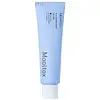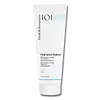What's inside
What's inside
 Key Ingredients
Key Ingredients

 Benefits
Benefits

 Ingredients Side-by-side
Ingredients Side-by-side

Water
Skin ConditioningSqualane
EmollientGlycerin
Humectant1,2-Hexanediol
Skin ConditioningNiacinamide
SmoothingBetaine
HumectantGlyceryl Glucoside
HumectantPanthenol
Skin ConditioningPolyglycerin-3
HumectantPolymethylsilsesquioxane
Melia Azadirachta Leaf Extract
Skin ConditioningMelia Azadirachta Flower Extract
Skin ConditioningHydrolyzed Gardenia Florida Extract
AntioxidantCentella Asiatica Root Extract
Skin ConditioningEnantia Chlorantha Bark Extract
Skin ConditioningAnemarrhena Asphodeloides Root Extract
Skin ConditioningTriticum Aestivum Peptide
Skin ConditioningSodium Hyaluronate
HumectantOryza Sativa Bran Oil
EmollientHydrogenated Lecithin
EmulsifyingHelianthus Annuus Seed Oil
EmollientAmmonium Acryloyldimethyltaurate/Vp Copolymer
Arginine
MaskingAcrylates/C10-30 Alkyl Acrylate Crosspolymer
Emulsion StabilisingGlucose
HumectantAdenosine
Skin ConditioningMaltodextrin
AbsorbentXylitol
HumectantButylene Glycol
HumectantAllantoin
Skin ConditioningEctoin
Skin ConditioningPolyglutamic Acid
Skin ConditioningHydrogenated Polyisobutene
EmollientXylitylglucoside
HumectantAnhydroxylitol
HumectantSucrose Palmitate
EmollientPropanediol
SolventGlyceryl Linoleate
EmollientCollagen
MoisturisingCeramide NP
Skin ConditioningTocopherol
AntioxidantLeuconostoc/Radish Root Ferment Filtrate
AntimicrobialHydroxypropyl Cyclodextrin
MaskingOleanolic Acid
Skin ConditioningAvena Sativa Peptide
Skin ConditioningCaprylic/Capric Triglyceride
MaskingGlycine Max Polypeptide
Skin ConditioningGlycine
BufferingGlutamic Acid
HumectantSucrose Distearate
EmollientPhytosphingosine
Skin ConditioningEthylhexylglycerin
Skin ConditioningWater, Squalane, Glycerin, 1,2-Hexanediol, Niacinamide, Betaine, Glyceryl Glucoside, Panthenol, Polyglycerin-3, Polymethylsilsesquioxane, Melia Azadirachta Leaf Extract, Melia Azadirachta Flower Extract, Hydrolyzed Gardenia Florida Extract, Centella Asiatica Root Extract, Enantia Chlorantha Bark Extract, Anemarrhena Asphodeloides Root Extract, Triticum Aestivum Peptide, Sodium Hyaluronate, Oryza Sativa Bran Oil, Hydrogenated Lecithin, Helianthus Annuus Seed Oil, Ammonium Acryloyldimethyltaurate/Vp Copolymer, Arginine, Acrylates/C10-30 Alkyl Acrylate Crosspolymer, Glucose, Adenosine, Maltodextrin, Xylitol, Butylene Glycol, Allantoin, Ectoin, Polyglutamic Acid, Hydrogenated Polyisobutene, Xylitylglucoside, Anhydroxylitol, Sucrose Palmitate, Propanediol, Glyceryl Linoleate, Collagen, Ceramide NP, Tocopherol, Leuconostoc/Radish Root Ferment Filtrate, Hydroxypropyl Cyclodextrin, Oleanolic Acid, Avena Sativa Peptide, Caprylic/Capric Triglyceride, Glycine Max Polypeptide, Glycine, Glutamic Acid, Sucrose Distearate, Phytosphingosine, Ethylhexylglycerin
Water
Skin ConditioningC15-19 Alkane
SolventGlycerin
HumectantCaprylic/Capric Triglyceride
MaskingPEG/PPG/Polybutylene Glycol-8/5/3 Glycerin
HumectantIsosorbide Dicaprylate
Skin ConditioningEctoin
Skin ConditioningXylitylglucoside
HumectantBisabolol
MaskingAllantoin
Skin ConditioningAnhydroxylitol
HumectantXylitol
HumectantHydroxyethyl Acrylate/Sodium Acryloyldimethyl Taurate Copolymer
Emulsion StabilisingAmmonium Acryloyldimethyltaurate/Vp Copolymer
Glucose
HumectantCitric Acid
BufferingTocopherol
AntioxidantEthylhexylglycerin
Skin ConditioningPhenoxyethanol
PreservativeWater, C15-19 Alkane, Glycerin, Caprylic/Capric Triglyceride, PEG/PPG/Polybutylene Glycol-8/5/3 Glycerin, Isosorbide Dicaprylate, Ectoin, Xylitylglucoside, Bisabolol, Allantoin, Anhydroxylitol, Xylitol, Hydroxyethyl Acrylate/Sodium Acryloyldimethyl Taurate Copolymer, Ammonium Acryloyldimethyltaurate/Vp Copolymer, Glucose, Citric Acid, Tocopherol, Ethylhexylglycerin, Phenoxyethanol
 Reviews
Reviews

Ingredients Explained
These ingredients are found in both products.
Ingredients higher up in an ingredient list are typically present in a larger amount.
Allantoin is a soothing ingredient known for its protective and moisturizingg properties. Because of this, it is often added to products with strong active ingredients.
Studies show higher concentrations of this ingredient can promote wound healing.
Though it can be derived from the comfrey plant, allantoin is produced synthetically for cosmetic products to ensure purity.
Learn more about AllantoinAmmonium Acryloyldimethyltaurate/Vp Copolymer (let's call it AAVC for short) is a synthetically created polymer. It's used as a film-forming agent and used to thicken the consistency of products.
AAVC is able to increase the consistency and viscosity of products due to its large molecule size. It also prevents ingredients from separating.
This ingredient is created from dehydrating xylitol in acidic conditions. Xylitol is a famous sugar and humectant.
Much like its predecessor, anhydroxylitol is a humectant. Humectants attract and hold water to moisturize the skin.
This ingredient is most commonly found in a popular trio called Aquaxyl. Aquaxyl is made up of anhydroxylitol (24 - 34%), xylitylglucoside (35 - 50%), and xylitol (5 - 15%).
According to a manufacturer, Aquaxyl is known for a 3-D hydration concept and an anti-dehydration shield to reinforce the outer layer of skin.
This ingredient is often derived from plants such as wood and sugarcane.
Learn more about AnhydroxylitolThis ingredient is an emollient, solvent, and texture enhancer. It is considered a skin-softener by helping the skin prevent moisture loss.
It helps thicken a product's formula and makes it easier to spread by dissolving clumping compounds.
Caprylic Triglyceride is made by combining glycerin with coconut oil, forming a clear liquid.
While there is an assumption Caprylic Triglyceride can clog pores due to it being derived from coconut oil, there is no research supporting this.
Learn more about Caprylic/Capric TriglycerideEctoin is a compound found naturally in some species of bacteria. It can be synthetically created for skincare use.
This ingredient is an osmolyte; Osmolytes help organisms survive osmotic shock (it protects them from extreme conditions). It does this by influencing the properties of biological fluids within cells.
When applied to the skin, ectoin helps bind water molecules to protect our skin. The water forms a sort of armor for the parts of our skin cells, enzymes, proteins, and more.
Besides this, ectoin has many uses in skincare:
A study from 2004 found ectoin to counteract the damage from UV-A exposure at different cell levels. It has also been shown to protect skin against both UV-A, UV-B rays, infrared light, and visible light.
Studies show ectoin to have dual-action pollution protection: first, it protects our skin from further pollution damage. Second, it helps repair damage from pollution.
In fact, ectoin has been shown to help with:
Fun fact: In the EU, ectoin is used in inhalation medication as an anti-pollution ingredient.
Ectoin is a highly stable ingredient. It has a wide pH range of 1-9. Light, oxygen, and temperature do not affect this ingredient.
Learn more about EctoinEthylhexylglycerin (we can't pronounce this either) is commonly used as a preservative and skin softener. It is derived from glyceryl.
You might see Ethylhexylglycerin often paired with other preservatives such as phenoxyethanol. Ethylhexylglycerin has been found to increase the effectiveness of these other preservatives.
Glucose is a simple sugar and is the most important source of energy in all organisms.
In skincare, glucose is used to hydrate the skin. It also acts as a prebiotic for our natural biome.
Glucose is hydrating due to its humectant property. As a humectant, glucose draws moisture from the air and from deeper levels in the skin.
Our skin contains many sugars that act as prebiotics and help strengthen our natural microbiome. Having a healthy microbiome helps protect our skin from harmful bacteria and other contaminants.
Studies show glucose may help with fading discoloration and pigmentation. This is because our skin metabolizes glucose into lactic acid. Lactic acid is an AHA that helps exfoliate the top layer of skin.
Learn more about GlucoseGlycerin is already naturally found in your skin. It helps moisturize and protect your skin.
A study from 2016 found glycerin to be more effective as a humectant than AHAs and hyaluronic acid.
As a humectant, it helps the skin stay hydrated by pulling moisture to your skin. The low molecular weight of glycerin allows it to pull moisture into the deeper layers of your skin.
Hydrated skin improves your skin barrier; Your skin barrier helps protect against irritants and bacteria.
Glycerin has also been found to have antimicrobial and antiviral properties. Due to these properties, glycerin is often used in wound and burn treatments.
In cosmetics, glycerin is usually derived from plants such as soybean or palm. However, it can also be sourced from animals, such as tallow or animal fat.
This ingredient is organic, colorless, odorless, and non-toxic.
Glycerin is the name for this ingredient in American English. British English uses Glycerol/Glycerine.
Learn more about GlycerinTocopherol (also known as Vitamin E) is a common antioxidant used to help protect the skin from free-radicals and strengthen the skin barrier. It's also fat soluble - this means our skin is great at absorbing it.
Vitamin E also helps keep your natural skin lipids healthy. Your lipid skin barrier naturally consists of lipids, ceramides, and fatty acids. Vitamin E offers extra protection for your skin’s lipid barrier, keeping your skin healthy and nourished.
Another benefit is a bit of UV protection. Vitamin E helps reduce the damage caused by UVB rays. (It should not replace your sunscreen). Combining it with Vitamin C can decrease sunburned cells and hyperpigmentation after UV exposure.
You might have noticed Vitamin E + C often paired together. This is because it is great at stabilizing Vitamin C. Using the two together helps increase the effectiveness of both ingredients.
There are often claims that Vitamin E can reduce/prevent scarring, but these claims haven't been confirmed by scientific research.
Learn more about TocopherolWater. It's the most common cosmetic ingredient of all. You'll usually see it at the top of ingredient lists, meaning that it makes up the largest part of the product.
So why is it so popular? Water most often acts as a solvent - this means that it helps dissolve other ingredients into the formulation.
You'll also recognize water as that liquid we all need to stay alive. If you see this, drink a glass of water. Stay hydrated!
Learn more about WaterXylitol is a humectant and prebiotic. It can help with dry skin.
In studies, xylitol has been shown to improve dry skin. It decreased transepidermal water loss, or when water passes through the skin and evaporates. Xylitol also showed to help improve the biomechanical properties of the skin barrier.
The prebiotic property of xylitol may also help reinforce our skin's natural microbiome. Having a healthy microbiome prevents infection by bad bacteria and helps with hydration.
As a humectant, Xylitol helps draw moisture from both the air and from deeper skin layers. This helps keep skin hydrated.
Xylitol is a sugar alcohol and commonly used as a sugar substitute. It is naturally occurring in plants such as strawberries and pumpkin.
Learn more about XylitolXylitylglucoside is created from xylitol and glucose, two humectants.
Not surprisingly, this ingredient is also a humectant. It attracts and holds water in your skin, helping to maintain hydration.
This ingredient is most commonly found in a popular trio called Aquaxyl. Aquaxyl is made up of anhydroxylitol(24 - 34%), xylitylglucoside (35 - 50%), and xylitol (5 - 15%).
According to a manufacturer, Aquaxyl is known for a 3-D hydration concept and an anti-dehydration shield to reinforce the outer layer of skin.
Learn more about Xylitylglucoside